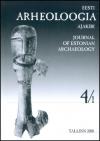“BURNING PELTS” – BROWN BEAR SKINS IN THE IRON AGE AND EARLY MEDIEVAL (1–1300 AD) BURIALS IN SOUTH-EASTERN FENNOSCANDIA
“BURNING PELTS” – BROWN BEAR SKINS IN THE IRON AGE AND EARLY MEDIEVAL (1–1300 AD) BURIALS IN SOUTH-EASTERN FENNOSCANDIA
Author(s): Tuija KirkinenSubject(s): Archaeology, Local History / Microhistory
Published by: Teaduste Akadeemia Kirjastus
Keywords: Fennoscandia;
Summary/Abstract: This paper deals with the use of brown bear (Ursus arctos) skins in the Iron Age and Early Medieval death rituals in south-eastern Fennoscandia. In this area, the practice of wrapping bodies in bear skins endured for over 1,000 years, starting in the Roman Iron Age in south-western Finland and ending with the Medieval Age inhumation burials in the Karelian Isthmus. The wrapping of bodies in predator skins is hypothesized by the numbers of 3rd phalanges (i.e. claws) which have been found in burials, especially in cremation cemeteries under level ground (400/600–1000 AD). Firstly, the role of the bear was studied by analysing bear skin remains, specifically the 3rd phalanges and bear hairs, which have been found in burials, and secondly finds and their find contexts were analysed in terms of references made to them in Finno-Karelian Kalevala-metric poetry. The results stress the role of bear skins in constructing the identity of the deceased as a warrior and as an ancestor. The concept of a warrior as a predator is widely known among Eurasian populations. In south-eastern Fennoscandia the distribution and find contexts indicate that this ritual was adopted mainly from the Germanic cultural sphere.
Journal: Eesti Arheoloogia Ajakiri
- Issue Year: 21/2017
- Issue No: 1
- Page Range: 3-29
- Page Count: 27
- Language: English

